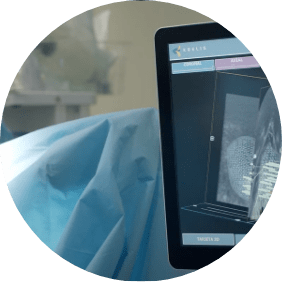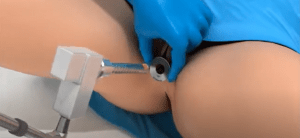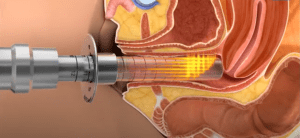Laser co2 in Urology
In Urology, the CO2 laser is used for the treatment of functional problems, as well as for the removal of condylomas or genital warts caused by HPV.


What is CO2 Laser?
The carbon dioxide laser (CO2 laser) is an advanced technology used for the treatment of tissue flaccidity, skin scars, wrinkles, blemishes, pores, etc. This laser applies small pulses of light with different intensities to the skin area to be treated by heating the tissues to the point of water evaporation. This allows to eliminate the superficial layers of the skin in a controlled way and stimulate the deeper layers, causing a regeneration of collagen and elastin fibers.
The CO2 laser reduces skin lesions by gently buffing away skin imperfections causing small microscopic wounds that heal quickly while collagen is produced and the skin regenerates and restores itself.
What applications does the CO2 laser have in Urology?
In the field of Urology, the CO2 laser is gaining great importance in the treatment of multiple conditions. In functional urology it is used to treat pathologies that affect the quality of life of women, such as urinary incontinence, pelvic organ prolapse, repeated urinary tract infections and vulvovaginal atrophy. CO2 laser is also a very effective technology for treating warts, also called genital warts, a sexually transmitted disease (STD) caused by the human papilloma virus (HPV), which affects the skin or mucous membranes causing fleshy lumps around the sexual organs.
The urologist specialist will evaluate each patient's case and skin type to determine the sessions and the intensity of the laser to be applied. An analgesic may be used during the sessions to reduce possible discomfort.
CO2 laser for the treatment of functional problems (vaginal laser)
The female genitourinary system is composed of the bladder, urethra, vagina and vulva. These organs are replete with estrogen receptors. At menopause, with the decrease in estrogen levels in the blood, atrophy of these tissues can occur and, with it, a decrease in collagen, elastic fibers and blood vessels; thinning of the epithelium; changes in vaginal pH; and colonization by gram-negative germs. This causes dryness, burning, vaginal irritation, insufficient lubrication, discomfort and pain, altered sexual function, incontinence, urinary urgency, painful urination (dysuria) and repeated urinary tract infections.


In these cases, the CO2 laser activates fibroblasts (cells that contribute to the formation of connective tissue) and collagen production and increases blood flow in response to heat. These effects restore elasticity, hydrate the vaginal canal, increase muscle tone, recolonize the germs present in the premenstrual vagina that act as a barrier, improve continence and sexual function, and even the aesthetics of the external vulvar tissues.
Postmenopausal women with some of these conditions - especially if they are contraindicated for estrogen use due to a history of breast or uterine cancer, or those who have experienced side effects to estrogen therapies - are candidates for CO2 laser treatment.
In women with genitourinary syndrome of menopause (vulvovaginal atrophy), i.e. with estrogen decrease and estrogen action deficit in the urogenital tissues after menopause, CO2 laser acts eliminating the damage caused by physiological aging, restoring, regenerating and reestablishing the normal appearance and functionality without side effects or further injury. It is estimated that up to 50% of postmenopausal women suffer from this syndrome.
On the other hand, in women suffering from repeated urinary tract infections, CO2 laser has been shown to reduce cystitis episodes per year thanks to pH reduction, vaginal recolonization by Lactobacilli and the disappearance of Enterobacteriaceae.
Likewise, women with stress urinary incontinence and pelvic organ prolapse benefit from the CO2 laser by strengthening the suburethral, periurethral and pubocervical fascia tissue.
Effectiveness of CO2 Laser in Functional Urology
CO2 laser achieves results from the first application, reaching its maximum effectiveness 4 weeks after the third application. Numerous studies show benefits up to 12-18 months after treatment. If necessary, reminder sessions can be performed.
What is the vaginal CO2 laser procedure like?
The CO2 laser application is ambulatory and does not require previous preparation. It is a minimally invasive treatment that is performed in 3 sessions with a time interval of 4 weeks between each one. It is not necessary to use anesthetics routinely, except in patients with hypersensitivity.
The procedure begins with a vaginal exploration and then the most appropriate probe is introduced into the vagina (the laser is equipped with several probes to adapt its application to the clinical and anatomical needs of the patient) and, thanks to a head that rotates 360 degrees emitting the energy beam, the entire surface of the vagina can be treated in approximately 15-20 minutes. There are also specific applicators for the genital lips.
Vaginal CO2 laser after care
As aftercare after the laser application, only the application of intimate moisturizing creams is recommended for a few days and periodic check-ups will be scheduled 7 days after each application. The patient can return to her normal life immediately.
CO2 laser for condyloma treatment
Condylomas or genital warts are lesions produced by the sexually transmitted human papilloma virus (HPV) that affect the skin of the genital area, causing multiple and polymorphous fleshy bumps, sometimes forming a large mass with a fissured and irregular surface. It can cause itching, burning, bleeding and pain. Additionally, some of these HPV lesions can cause premalignant lesions and/or malignant tumors.
In males, condyloma is usually located on the frenulum, balanopreputial sulcus and inner surface of the foreskin. In women, it is located on the vulva, perineum and anus. The anatomical characteristics of the female genital tract cause them to spread rapidly to the vagina and cervix. They can also appear in anal location.
There are several ways to treat genital warts or condylomas, but CO2 laser vaporization is the most effective method. The laser concentrates the thermal energy on small strips of tissue, thus coagulating the exact spot of the lesion and preventing damage to the surrounding healthy genital tissue.
Compared to conventional techniques, the CO2 laser has the advantage of rapid disappearance of lesions and lower recurrence rates. However, as condylomas have high recurrence rates, close follow-up is necessary to monitor their possible appearance several months after treatment.
Likewise, CO2 lasers provide better healing than other techniques, thus minimizing post-treatment discomfort and shortening the postoperative period.
How is the treatment of condyloma with CO2 laser?
The CO2 laser lesion removal procedure is very fast and comfortable for the patient. First, the area to be treated is anesthetized to minimize discomfort. Subsequently, the specialist will apply the CO2 laser with the most appropriate intensity according to each case and in a very precise manner in order to control the exact depth to be reached. In this way, the lesion is eliminated, minimizing the risk of subsequent scarring. In 90% of cases only one session is needed to completely eliminate the condyloma.
The duration of the process will depend on each case, and may vary between 10 and 30 minutes depending on the lesion.
In the case of internal lesions (cervical, intraurethral or intra-anal), the duration of treatment for laser condyloma removal will depend on the number of lesions and whether the patient requires sedation to treat them.
In general, laser treatment to remove condylomas or genital warts does not cause pain or discomfort.
CO2 laser condyloma removal aftercare
After treatment of condyloma with CO2 laser, it is normal for the area to be slightly inflamed with a slight burning sensation, itching and tightness. Also, small wounds may appear with bleeding for 24-48h and a crust that will disappear in about a week, with redness persisting for a while. The inflammation will progressively disappear in 3-5 days.
Over time, it will disappear completely without usually leaving any mark, so the aesthetic result is usually excellent.
Some recommendations to follow after condyloma treatment:
- Avoid wearing tight-fitting clothing for two days after treatment to prevent chafing from irritating the area.
- Apply the cream indicated by your doctor.
- Do not swim or perform strenuous exercise until 72 hours later.
- Do not rub the treated area with the towel. Dry carefully.
- Avoid contact sports or excessive sweating while the wound is red.
- If scabs appear, do not pick them off.
- If blisters appear, call your doctor.
- Minimally invasive, no-scalpel surgery
- No bleeding
- Shorter postoperative time
- Faster healing speed
- Lower degree of recurrences
- Better aesthetic finish
- Excellent treatment effectiveness from the first application
- Fast recovery
- Suitable for pregnant women.
- The effect of CO2 laser in functional urology is slower than ablative laser and requires several sessions to achieve an equivalent effect.
Newsof ROC Clinic in Laser Co2 in Urology
Research
High-Intensity Focused Ultrasound (HIFU) for Prostate Cancer – Step-by-Step Technique
They ask us in the Consultation
How long after having sex with an infected person can genital warts appear?
Condylomas or genital warts can appear several weeks, months or years after having sex with someone who has the papillomavirus. This makes it difficult to know exactly when or with whom the virus was contracted.
Can I spread genital warts even if I do not have the lesions present?
It is most likely to be transmitted when genital warts or condylomas are present, however, it can also be transmitted even if there are no visible warts at the time of sexual intercourse.
What additional risks can a woman with genital warts have?
Genital warts in women may carry additional risks beyond the visible lesions. Therefore, they should be screened for cervical warts. There is evidence that HPV infection can cause cervical cancer. You should additionally consult your gynecologist for a cervical cytology (Pap test) to rule out pathologies such as cervical cancer early.
What are the associated risks between genital warts and pregnancy?
Condylomas can cause numerous problems during pregnancy: - Accelerated growth of warts: due to the hormonal and immune system changes inherent in pregnancy, genital warts may increase in size and number, which could cause discomfort or complications during childbirth or make urination difficult. - Transmission to the newborn: Although rare, there is a possibility that HPV could be transmitted to the baby during vaginal delivery, which could lead to warts in the newborn's throat, a condition known as recurrent respiratory papillomatosis. It is critical that pregnant women with genital warts maintain regular medical follow-up to properly assess and manage these risks, ensuring both their health and that of the baby.
Team of the Laser co2 unit in Urology.


 +34 912 627 104
+34 912 627 104 Contact
Contact








